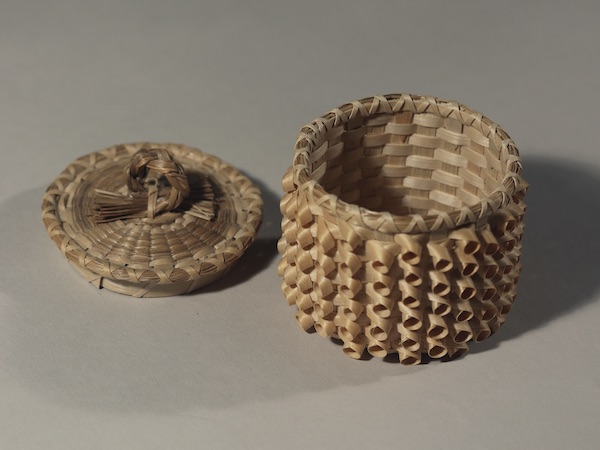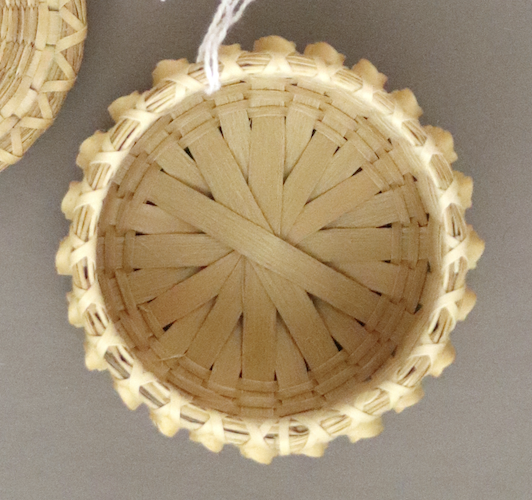Basket makers began twisting points and looping curls in their baskets during the middle of the nineteenth century, leading to the name “fancy” baskets. Half a century earlier, the state of Maine had forced Wabanaki Confederacy members onto reservations to open their land for white settlement. Basket making became a source of income and self-sufficiency as communities adapted to their new conditions. By 1900, over two-thirds of residents on the Penobscot reservation at Indian Island listed “basket making” as their primary source of income on the census.[1] Entire families participated in the process, allowing communities to support themselves while maintaining social and cultural relationships.
Caron Shay (Penobscot Nation) spent her childhood traveling with her parents, Madeline Tomer Shay (Penobscot Nation) and Billy Shay (Penobscot Nation), to basket camps where they sold decorative fancy baskets.[2] Resorts at Kennebunkport and Bar Harbor on Mount Desert Island drew crowds of tourists every summer. In response to contemporary consumer tastes, basket makers made increasingly elaborate baskets. Many basket makers used the freedom of making work that did not have to serve a particular function to expand the possibilities of basket forms. Other families made utility baskets for harvesting potatoes or saving fish scales in processing plants. By the 1960s, fewer and fewer families could rely on basket making as a primary source of income. A dip in tourism after the Great Depression and World War II led to less demand for fancy baskets and the introduction of plastics led to fewer and fewer orders for utility baskets.
Caron’s parents were part of a dwindling number of basket makers still active by the 1990s. In addition to teaching their daughter how to weave, they helped found Maine Indian Basketmakers Alliance (MIBA) in 1993 to ensure that other artists had the opportunity to apprentice.[3] The Shay family is known for the tight curls that Caron Shay used to decorate the basket shown above. Inside the basket, the standards radiate out, layered one atop the other, to form the basket’s base. Sweetgrass encircles the rim held in place with thin, crisscrossed weavers. More strands of sweetgrass adorn the lid, topped off by a braided sweetgrass handle.
Up until the 1960s, the hollow thump of splints being pounded from trunks of ash had resonated through Wabanaki communities every summer. As basket making waned, the sound all but disappeared. When basket maker Jeremy Frey (Passamaquoddy Tribe at Indian Township) moved to the town of Indian Island on the Penobscot Reservation with his wife and fellow artist, Ganessa Frey (Penobscot Nation), the sound of his pounding on ash logs brought people walking slowly by his house, hungry for the reverberations that used to define the summer months.[4] His lidded porcupine basket demonstrates why many basket makers harvest their own ash trees to ensure the quality of their splints. If the ash is too thin or brittle, it cannot bend into sharp, twisted points without cracking. Both Jeremy and his brother, Gabriel Frey (Passamaquoddy Tribe at Indian Township), harvest and process their own ash. They originally learned how to weave from their mother, Frances (Gal) Frey Tomah (Passamaquoddy Tribe at Indian Township). In 2011, Jeremy won Best in Show at the Santa Fe Indian Market, an event that gathers Indigenous artists from across the United States. His baskets have since been collected nationally and internationally.
Color has always played a role in Wabanaki basket making. Baskets were originally stained with natural dyes like indigo, but as soon as bright manufactured aniline dyes appeared in the late nineteenth-century basket weavers adopted them. Rocky Keezer (Passamaquoddy Tribe at Sipayik [or Pleasant Point]) dyed the weavers of his basket purple to draw attention to the porcupine points. His mother, Clara Neptune Keezer (Passamaquoddy Tribe at Sipayik [or Pleasant Point]), grew up making baskets with her grandparents. She continued to do so throughout her life, teaching both Rocky and his brother, Kenny. Clara, Rocky, and Kenny all make baskets in a profusion of colors.
[1] Lisa K. Neuman, “Basketry as Economic Enterprise and Cultural Revitalization: The Case of the Wabanaki Tribes of Maine,” Wicazo Sa Review 25, no. 2 (2010): 93.
[2] David Shultz, Baskets of Time: Profiles of Maine Indian Basket Makers (Kennebunkport: Home & Away Gallery, 2017), 118.
[3] Shultz, Baskets of Time, 120.
[4] Shultz, Baskets of Time, 70.




![Rocky Keezer (Passamaquoddy Tribe at Sipayik [or Pleasant Point], Maine, b. 1969), Natural and Purple Woven Porcupine Basket, ca. 2008, dyed and natural brown ash, sweetgrass. Rocky Keezer (Passamaquoddy Tribe at Sipayik [or Pleasant Point], Maine, b. 1969), Natural and Purple Woven Porcupine Basket, ca. 2008, dyed and natural brown ash, sweetgrass.](https://exhibitions.lib.udel.edu/contemporary-wabanaki-baskets/wp-content/uploads/sites/273/2023/04/keezer_purple_porcupine.jpg)
